Oh my God, how can I write this? There are so many beautiful and most beautiful places on the wild Atlantic coast, especially cliffs. It’s like carrying owls to Athens…
Page Contents (click line to jump the text)
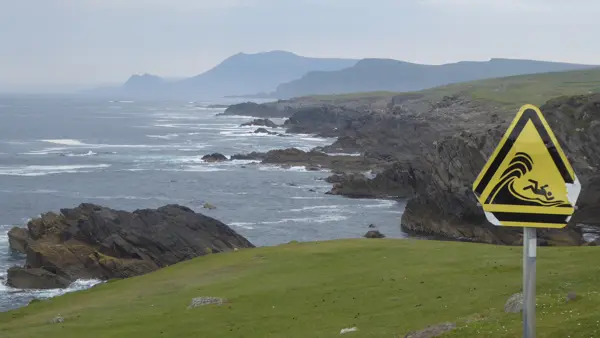
Intro
But let’s start at the beginning: The Wild Atlantic Way is not named for nothing. Here, the foothills of the Gulf Stream reach land again for the first time after several thousand kilometres of travel – and they don’t arrive quietly and leisurely, but with power!
They bring relatively warm water to the coasts – which ensures a constant cool temperate weather on the island. Summers are warm but not hot and winters are cool to cold but frost is rare. Without the Gulf Stream, the climate in northern Europe would be much colder, especially in Ireland. Here, metre-high rhododendrons and palm trees grow all year round.
The Gulf Stream also brings plankton and micro-organisms to the coasts of Ireland. Small and larger fish, such as the basking sharks, and also numerous whales, such as the humpback whale, feed on this. The well-fed schools of mackerel and herring in turn attract large predators such as tuna, dolphins, sharks, and even orcas. The marine life on the Irish coasts is exceedingly rich, bringing the best fish, oysters, crabs and lobsters and other seafood to the restaurant menus.
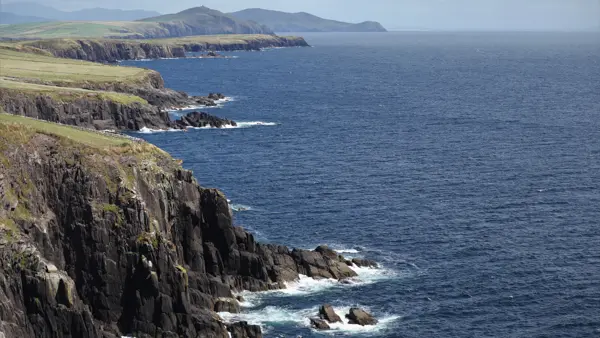
When warm and cool water masses meet, this also has an effect on the air masses above – weather develops, or rather, the weather changes.
The main wind direction is from the west. The westerly wind brings relatively warm air masses to the coast. Warm air masses can store more water than cold ones. Where the clouds of the Atlantic meet the mountains of mainland Ireland, they partially lighten – it rains. This is why it rains about twice as much on the Irish west coast as on the east coast. In winter, it often lasts for days.
In summer there can always be light showers, usually it’s an interplay of sun, clouds, showers, sun again etc… As it’s usually windy, or even very windy, this change can happen very quickly. You haven’t quite got your rain gear on yet, and the sun comes out again….
The Atlantic coast, despite the wind, the waves and the weather, which travels thousands of kilometres and crashes against the coasts. These elemental forces shape and change the face of the coast.
Sandy beaches emerge and change. High cliffs emerge – and then plunge into the sea. Waves, wind and rain create unique landscapes. The high cliffs, in turn, are home and breeding grounds for millions of seabirds that live off the Atlantic’s abundance of fish.
These are the cliffs we are talking about here: The face of the wild Atlantic coast in the west of Ireland.
By the way, I know all the cliffs myself from my own motorbike trips. We have our second home in Ireland and we had our own motorcycle rental business here for a number of years.
The Cliffs of Slieve League
These are the highest cliffs in Ireland and they are among the highest cliffs in Europe. As they are far to the north-west, in County Donegal, they attract far fewer tourists than the Cliffs of Moher. For this reason alone, you should include them in your motorbike tour. From Teelin, you will find signs to Bunglass Point, the name of the viewpoint. There are two parking areas. If you don’t want to hike up the steep slope in motorbike boots, take the upper one.

2 The Cliffs of Moher
The Cliffs of Moher are one of Ireland’s most important and most visited attractions. They are the second highest cliffs in Ireland. You won’t be alone when you visit them, but I highly recommend it anyway. Don’t be put off by the crowded car park, the site is spacious and visitors are well spread out. The cliffs are spectacularly beautiful (see cover photo). There is also a restaurant and a small exhibition on the cliffs inside an artificial cave – very well done.
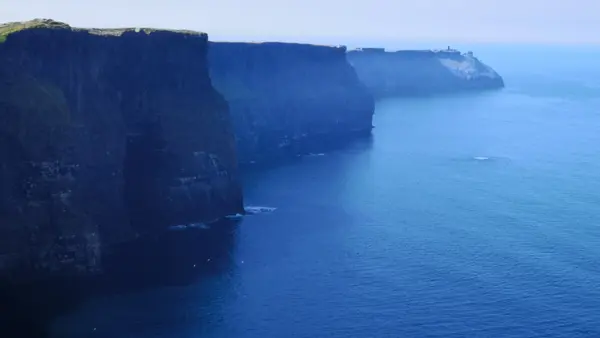
3 The Kerry Cliffs Portmagee
On the Ring of Kerry, not far from Portmagee are the Kerry Cliffs. They are much smaller than the Cliffs of Moher, but very beautiful to see.
4 The Cliffs at the Baltimore Beacon
In the far southwest lies the small town of Baltimore in an elongated bay with offshore islands. It used to be a fishing village, but is now a holiday resort. Follow the signs to the Baltimore Beacon, the sea marker that marks the entrance to the bay. Walk up the few metres to the Beacon and you will stand on a large cliff overlooking many more cliffs. Really beautiful!
5 The Cliffs at Mizen Head Signal Station
Mizen Head Signal Station is an old marine radio station. In the old days this was the last contact of ships on their way to America – or the first contact with the mainland when coming from America. The little radio station is nestled against the cliffs like a bird’s nest – an incredible location and beautiful to visit.
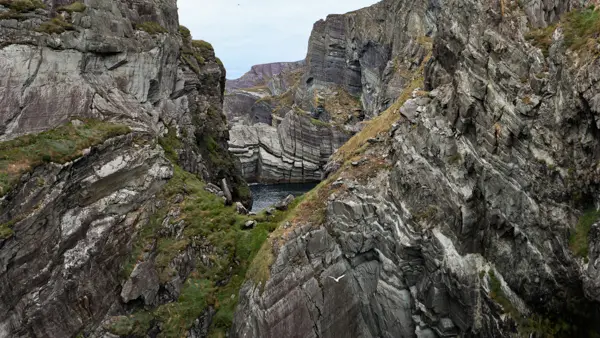
6 The Cliffs at Loop Head Lighthouse
West of Limerick, at the mouth of the Shannon, is Loop Head. The headland forms high vertical cliffs at the very end and that’s where the lighthouse stands – a beautiful corner and not crowded.
7 The Kilkee Cliffs
Kilkee is a nice seaside resort, a bit north of Loop Head. On the way there, the road runs very close to the cliff edge and at Kilkee there are high cliffs with a viewpoint.
8 The White Cliffs of Ashleam
Achill Island – I always rave about it. The island is easily accessible via a small bridge. It is a little out of the way, so that overseas tourists often don’t get there. But the Irish know where it is beautiful and like to visit Achill Island. Me too! On the south coast you have a beautiful coastal road that passes many cliffs, including the white cliffs of Ashleam. You’ll recognise them – they really are almost white.
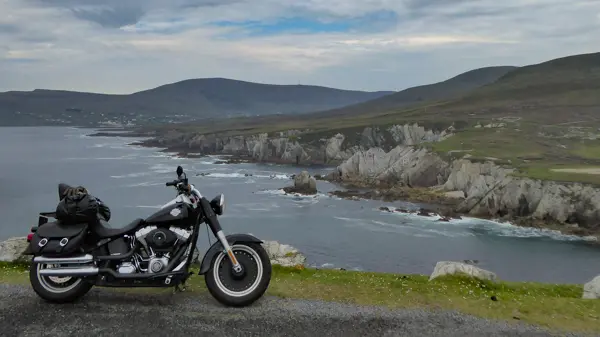
9 The Cliffs of Dingle
The Dingle Peninsula is just north of the Ring of Kerry. As you drive the beautiful coastal road around Slea Head, stop and look in both directions: Dingle has a very high and beautiful coastline!
10 The Cliffs of the Burren Coastal Route
The Burren is a barren range of hills south of Galway. The coastal road around the headland into Galway Bay is particularly beautiful. Here you drive right along the sea, which lies several metres below you – the cliffs I mean.
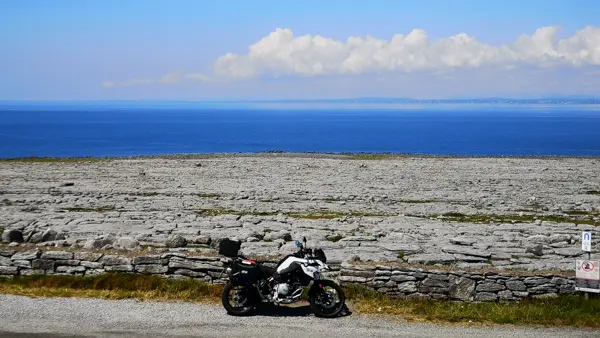
11 The Cliffs of Valentia Island
Valentia Island is a small island off the coast of the Ring of Kerry. It is accessible via a bridge at one end and a small ferry at the other. It has beautiful cliffs on the west side, the Geokaun Cliffs and the Fogher Cliffs. 12.
12 The Cleggan Cliffs in Connemara
On the west coast of Connemara you will find the Cleggan Cliffs. However, they are difficult to reach from the village of Cleggan, better from Ballynew Beach.

13 The Cliffs at Cèide Fields and Downpatrick Head
To the west of Sligo is Downpatrick Head, a popular photo spot with magnificent cliffs and an offshore rock outcrop. If you follow the coast road a little further west, you will come to the ceiba Fields, probably the largest prehistoric archaeological site in Ireland. There is a small museum with a café, the excavation sites and a viewpoint of the almost vertical, high cliffs in front of the car park.
14 The Cliffs of Glencolumbcille
Glencolumcille is a small town in the northwest of Ireland. The location is incredible! Beach, high cliffs, rocks and mountains in the background. Enjoy the views of the great coastline and visit the Folk Village a few metres away. This is a small but very beautiful open-air museum. It consists of just a few cottages and a café and shows the life of the simple people in such a village in former times.
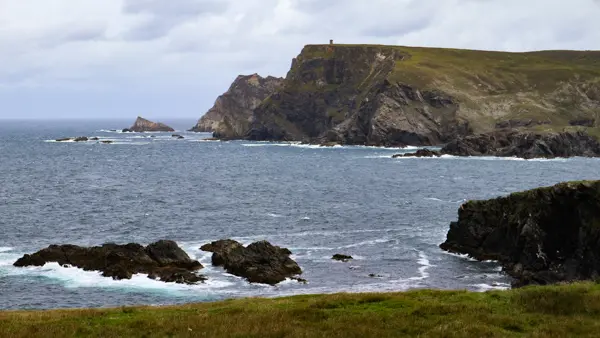
Conclusion
The Wild Atlantic Way is spectacular, really! The small road sometimes leads directly past the coast and sometimes it winds through the hills and mountains of the hinterland. But again and again it finds its way back to the coast and again and again you will stop and take photos because it is just beautiful. The beaches, and especially the cliffs!
More interesting articles for you:
IRELAND MOTORBIKE TOUR – 24 BEAUTIFUL BEACHES ON THE WILD ATLANTIC WAY
8 GREAT CASTLES YOU SHOULD SEE ON YOUR MOTORBIKE TOUR IN IRELAND!
THE 13 MOST BEAUTIFUL MOTORBIKE TOURS ON THE IRISH ISLAND
THE BEST MOUNTAIN ROADS AND PASSES FOR MOTORCYCLISTS IN IRELAND – PART 1: OVERVIEW & THE SOUTH EAST
Photo credits cover photo: Seagull over the Cliffs of Moher, photo by Ulrich Knüppel-Gertberg (www.irland-insider.de, www.ireland-insider.com)